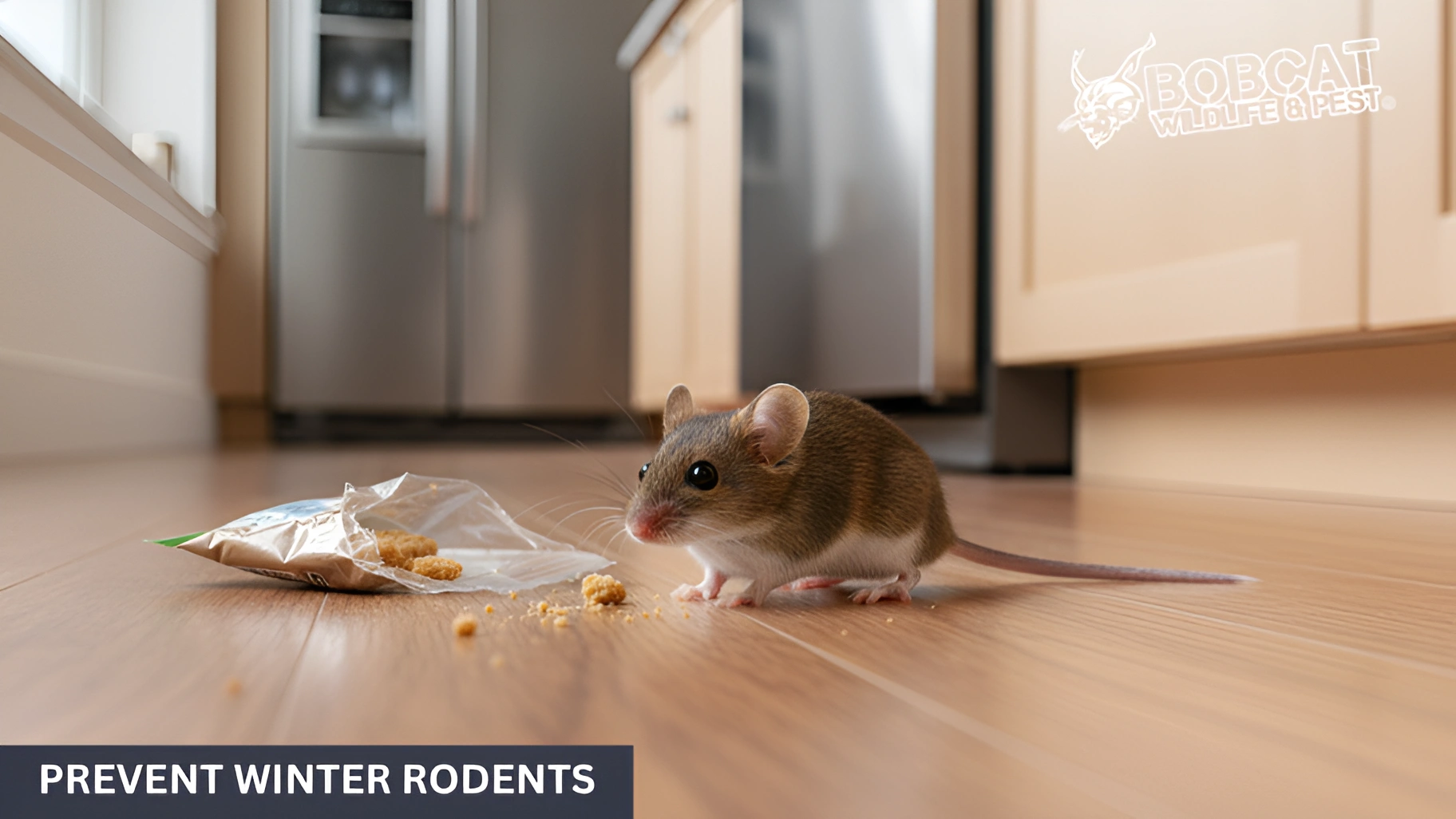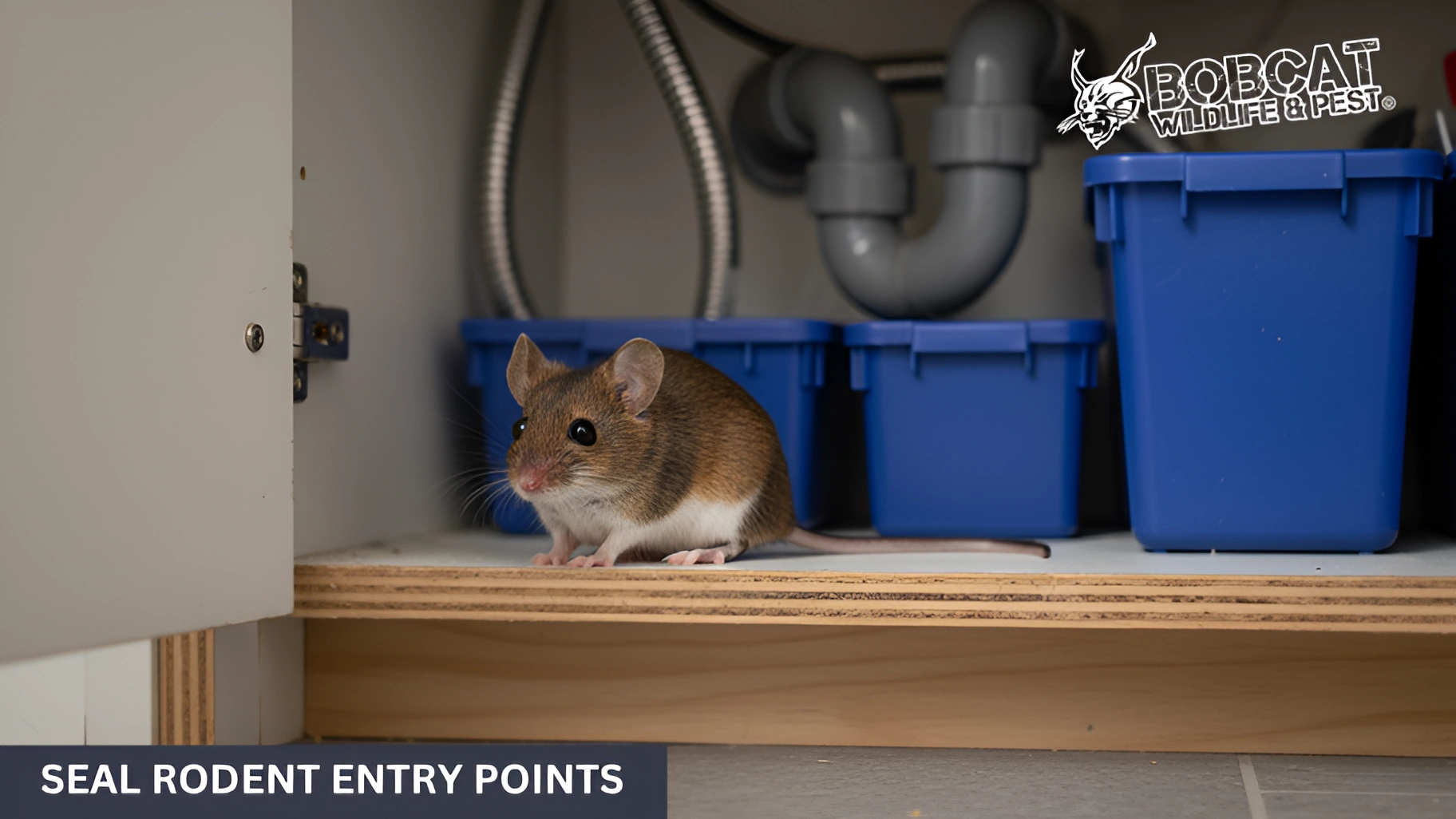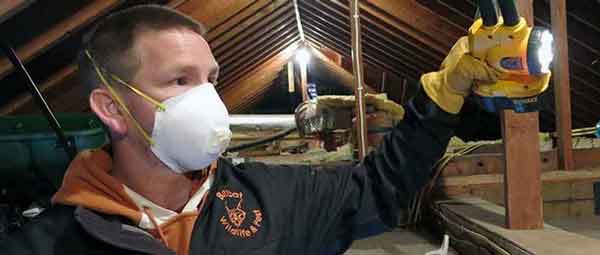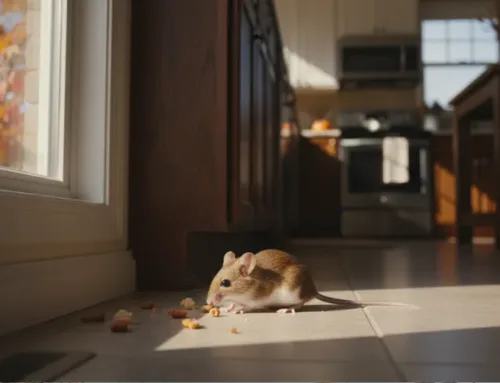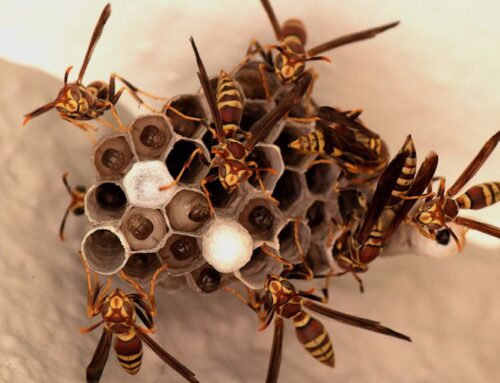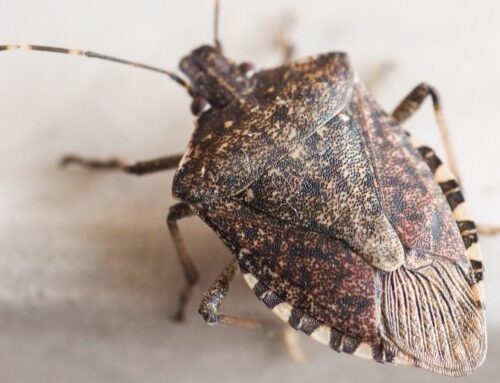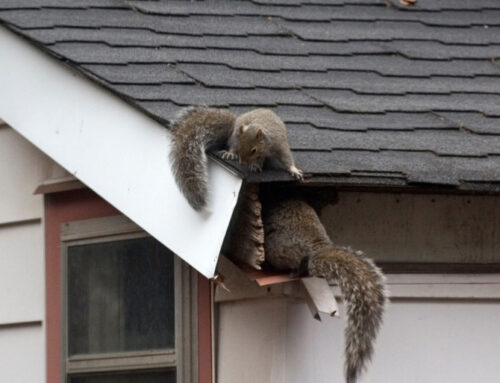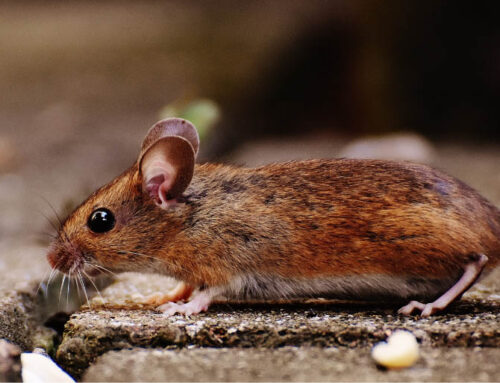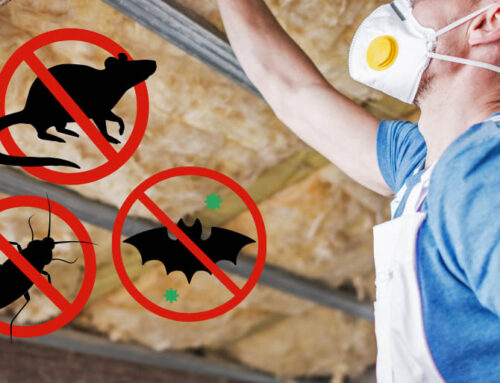As temperatures drop in Des Moines, rodents, including mice and rats, seek warmth indoors, making your home an ideal place for them to nest.
Without proper rodent-proofing, these pests can cause damage and spread diseases.
In this guide, we’ll walk you through the simple steps to rodent proof your house this winter, from sealing entry points to removing attractants.
Whether you’re preventing an infestation or already dealing with one, we’ll show you how to keep your home safe from rodents all winter long.
Why rodent-proofing your Des Moines home is essential.
Easy, actionable steps to stop mice from entering your home.
How to seal gaps and maintain rodent-proofing.
What to do if you already have a mouse problem and when to call professional rodent control.
What You’ll Learn About Keeping Rodents Out:
Why Rodent-Proofing Your Des Moines Home This Winter Is Essential
With winter setting in, rodents like mice and rats are searching for warm places to hide.
Rodent-proofing your home now helps keep them from finding a way inside.
Taking action now helps you avoid costly damage to your home and reduces the health risks that come with having rodents inside.
Immediate Benefits of Rodent-Proofing:
Prevent costly damage to wiring, insulation, and your home’s structure.
Protect your family’s health by keeping disease-carrying rodents out.
Avoid costly repairs by addressing rodent issues before they develop into a full infestation.
4 Simple Steps to Rodent-Proof Your Home This Winter
Worried about rodents invading your home? Follow these 4 simple steps to keep mice and rats from turning your house into their winter hideaway.
Step 1 – Remove Attractants Inside Your Home
Rodents are constantly looking for food, and your kitchen and pantry are prime targets. If there’s an easy meal, they’ll find it.
Here’s how you can eliminate food sources that attract mice:
Store food in airtight containers: Keep anything edible secured in solid, sealable containers. This includes items like cereal, flour, sugar, snacks, and even your pet’s food.
Clean regularly: Wipe down surfaces after meals, sweep up crumbs, and ensure food isn’t left out overnight.
Secure trash: Make sure your trash cans are sealed tightly and take them out regularly.
By removing all easy food sources, you reduce the chances of attracting rodents to your home in the first place.
Step 2 – Locate and Seal Entry Points
You might be surprised at how easily rodents can sneak inside. Mice can fit through gaps smaller than the size of a dime.
Here’s how to find and seal those entry points:
Check doors and windows: Gaps around doors or windows are common entry points. Make sure weather stripping is intact and replace any worn-out seals.
Inspect vents and pipes: Rodents often enter through gaps around pipes, ducts, or vents. Check around your home’s plumbing and HVAC systems.
Look for cracks in the foundation: Even the smallest crack in your foundation could let mice in. Be thorough and check both inside and outside your home.
Once you find any entry points, it’s time to seal them up — don’t leave any gaps!
Step 3 – Exclude and Repair (Seal Up Gaps and Holes)
After finding the entry points, sealing them up is the next critical step. This will keep rodents from coming back in.
Here’s how to seal the gaps:
Install fresh weatherstripping: Adding new weatherstripping around windows and doors helps close small spaces that mice could squeeze through.
Fill holes with steel wool: For any small holes around pipes or vents, fill them with steel wool and then seal with caulk or foam to keep rodents out.
Caulk and foam: Use caulk or expandable foam to fill cracks in walls, ceilings, and foundation lines.
These affordable solutions can be done with basic tools, and once you seal up the gaps, you’re taking a huge step toward keeping your home rodent-free.
Step 4 – Maintain Your Rodent-Proofing Efforts
Rodent-proofing doesn’t stop once the gaps are sealed. Regular maintenance ensures that your efforts last throughout the winter:
Check regularly: Set aside time once a month to walk through your home and recheck for new gaps or signs of wear. If you spot anything, seal it promptly to stay protected.
Keep food stored securely: Don’t let your guard down once the initial rodent-proofing is done. Keep food sealed and trash bins emptied regularly.
Check for new signs: Watch for droppings or gnaw marks that might indicate new rodent activity.
By keeping up with these small tasks, you’ll have long-term protection and peace of mind, knowing that your home is sealed and secure.
How to Know if You Already Have a Rodent Problem
If you’ve noticed any signs of rodents in your home, it’s time to take action.
Here are the key indicators to help you determine if you already have a rodent problem:
Droppings: Small pellet-like droppings around cupboards, along baseboards, or in tucked‑away spots such as attics and basements often indicate that mice have been active in your home.
Gnaw Marks: Rodents love to chew on materials like wood, wires, and insulation. Look for fresh gnaw marks, especially around food packages, boxes, or your home’s entry points.
Noises After Dark: Hearing light scratching or quick movement sounds inside walls or ceilings during nighttime often points to active rodent activity in your home.
Nests and Tracks: Rodents often build nests from shredded paper, fabric, or insulation. Look for these signs in secluded spots. You may also notice tracks in dusty or dirty areas, as rodents tend to travel the same paths.
Unexplained Odors: A musty or urine-like smell in enclosed spaces like your attic, basement, or walls could point to a rodent infestation.
What to Do if You Spot Signs of a Rodent Problem:
If you notice any of these signs, it’s important to act quickly. Here’s what you can do next:
Check your home carefully: Take a close look around the areas where you’ve seen activity. Focus on corners, utility lines, and hidden spots where gaps or small openings may be letting rodents in.
Seal gaps immediately: As we discussed in the previous section, sealing any gaps or holes is the first step in preventing further entry.
Consider professional help: If the signs are widespread or you suspect a larger infestation, it might be time to call in a professional rodent inspection.
Schedule a rodent inspection today to get a comprehensive look at your home’s rodent situation and ensure that your home is protected this winter.
What If I Already Have a Rodent Problem?
If you’ve noticed signs of rodents or suspect you have an infestation, don’t panic. It’s important to act quickly to stop the problem from getting worse.
Here’s what you can do immediately:
1. Set Traps and Bait Stations
Traps are one of the fastest ways to start lowering rodent activity in your home.
Here’s how to use them effectively:
Place traps near entry points: Set up traps where you’ve noticed signs of activity, such as along walls, near food sources, or in the attic.
Use both snap traps and bait stations: Snap traps kill mice quickly, while bait stations help control a larger infestation.
Check traps daily: Regularly inspect traps and replace bait to keep them effective.
Rodents are always searching for easy meals, so keeping food protected is one of the best ways to keep them away:
Use sealed containers for all food items: Keep things like pet food, cereal, grains, and other pantry goods in tight-closing containers so mice can’t smell or access them.
Clean up crumbs and spills: Sweep your floors, wipe down counters, and keep areas like your pantry spotless.
If there are still openings around your home where mice could squeeze through, make sure to close them right away:
Focus on doors, windows, and vents: These are common entry points for rodents.
Use steel wool or caulk: Stuff small holes with steel wool, then seal them with caulk or foam to ensure mice can’t squeeze through.
4. Call for Professional Help
If your efforts aren’t enough or you’re dealing with a larger infestation, it’s time to call in professional mouse control experts:
Rodent control professionals have the experience and tools needed to effectively deal with infestations.
Bobcat Wildlife & Pest offers comprehensive inspections, traps, and rodent-proofing services to ensure your home stays safe from future problems.
Need Professional Help? Get Expert Mice Removal Services in Des Moines
If you’ve tried the steps to rodent-proof your home but still have a rodent problem, or if you prefer to leave it to the professionals, Bobcat Wildlife & Pest is here to help.
With our local expertise and rapid response times, we ensure your home stays safe and rodent-free.
Why Choose Our Mice Removal Services?
Local Expertise:
Our team at Bobcat Wildlife & Pest has years of experience providing rodent control in Des Moines. We understand the local climate and know exactly how to address the rodent problems that are common in this area.
Comprehensive Solutions:
We don’t just remove the mice; we identify and address the root cause of the infestation, ensuring that you don’t face the same problem again. Our goal is long-term solutions, not just quick fixes.
Safe & Effective Techniques:
Our team uses proven, family-friendly methods to remove rodents and secure your home. The approach is designed to protect your household and pets while clearing out the infestation and keeping your space rodent-free long-term.
Quick Response Time:
We understand how urgent rodent problems can be, especially in the winter. Contact us today, and we’ll provide a rapid response to assess and eliminate the problem as quickly as possible.
Get Mice Removal Today – Call Us for a Consultation
If you’ve noticed signs of a rodent problem or just want peace of mind, don’t wait.
Contact Bobcat Wildlife & Pest today for a consultation. Our team will quickly evaluate your home and provide effective solutions to ensure your home is rodent-free this winter.
Frequently Asked Questions About Rodent Proofing in Des Moines
Mice are sneaky, and by the time you notice them, they could already be nesting inside.
Look out for:
- Droppings: Mice leave small, dark droppings around food sources, under sinks, or in hidden areas like attics.
- Gnaw Marks: Check your food packaging, furniture, or wooden baseboards for fresh marks. Mice often chew on things to keep their teeth from growing too long.
- Noises: If you hear scratching or scurrying, especially at night, mice are likely active behind your walls or in attics.
- Odors: A musky smell in hidden areas like basements can also indicate rodent presence.
Early detection is crucial. If you spot these signs, it’s time to act before the issue escalates.
Mice often slip into homes through tiny openings, so it helps to look closely in these key spots:
- Doors & Windows: Look for gaps, cracks, or worn-out seals. Ensure weather stripping is intact to prevent easy access.
- Vents & Pipes: Mice can squeeze through spaces around plumbing pipes, ducts, or vents. Check these areas carefully, especially in kitchens and bathrooms.
- Foundation & Walls: Small gaps along the foundation or lower walls can easily become entry points for mice. Take a flashlight and check around the base of your home, especially in low-light spots like basements and corners.
Sealing up these entry points is crucial to preventing rodents from entering your home.
Mice can slip through extremely small openings, often as tight as a quarter of an inch.
If a gap is roughly the width of a pencil, it’s usually big enough for them to squeeze through.
Their skulls are small enough to allow them to slip through tight spaces, which is why thorough inspection is so important.
Even the smallest cracks, holes, or gaps around pipes and doors can serve as a pathway for mice to enter your home.
- Kitchen & Pantry: Mice are often attracted to food, so check the edges of cupboards, under sinks, and around pantry shelves. Look for gaps where pipes enter or where the floor meets walls.
- Basements & Attics: Mice frequently use these spaces to get into your home. Check for holes around ducts, pipes, and vents. Look for any gaps along walls or ceilings.
- Doors & Windows: Ensure all doors close tightly, and check window seals for gaps or cracks.
Inspecting these areas helps identify and seal up potential entry points before mice can move in.
To keep mice from slipping into your home, focus on closing up the small openings they use to get inside.
Here are simple materials that work well:
- Steel wool: Pack steel wool into tiny openings such as the spaces around plumbing lines or vents. Its rough texture makes it difficult for rodents to chew through.
- Sealants: For bigger gaps, apply a strong sealant like silicone caulk or an expanding foam product. These materials fill the space tightly and help block out rodents.
- Weatherstripping: Install weatherstripping around windows and exterior doors. This helps close thin gaps where mice might squeeze through.
Closing off these access points creates a strong barrier and is one of the most reliable ways to keep rodents from entering your home.
The best materials for rodent-proofing include:
- Steel Wool: Great for filling small holes and cracks, especially around pipes or vents.
- Caulk & Expanding Foam: Use caulk or expanding foam to fill larger cracks and holes in walls, ceilings, or around windows and doors.
- Weatherstripping: Ideal for sealing doors and windows, preventing rodents from sneaking in.
- Copper Mesh: For larger gaps, copper mesh is effective at blocking mice, as they cannot chew through it like they can with foam or plastic.
Using these materials ensures that you create a long-lasting barrier that rodents cannot easily get past.
Yes, mice are excellent climbers. They can easily climb walls, pipes, and even furniture.
They can also jump up to 12 inches, which means they can reach high places, such as countertops or shelves, where food might be stored.
Mice can also use highways like electrical cables or plumbing to travel throughout your home.
To prevent them from accessing higher places, be sure to block all possible entry points from the ground up.
In the colder months, mice are actively searching for:
- Food: Leftover crumbs, pet food, or open containers of food in your kitchen and pantry.
- Warmth: Your home provides the warmth they seek during the winter months. They’re especially drawn to attics, basements, and areas with insulation.
- Shelter: Mice need a safe, secluded spot to nest, and they’ll use your home’s hidden corners, behind walls, or in the attic to find shelter.
By removing food and sealing entry points, you can make your home less appealing to rodents.
Mice are constantly searching for food, especially in the winter months.
To prevent them from making your kitchen and pantry their feeding grounds, take these simple but effective steps:
- Keep food sealed properly: Store items like flour, cereal, and grains in airtight containers to keep them safe from rodents. This prevents easy access and makes it harder for pests to find food sources.
- Clean regularly: Wipe down countertops and sweep up crumbs after meals. Don’t leave food out overnight.
- Seal pantry gaps: Check your pantry shelves and seal any gaps around doors or walls.
These small steps help ensure your kitchen remains rodent-free.
Yes, rodent-proofing is entirely possible without poison.
By focusing on sealing entry points, removing food sources, and using traps, you can effectively manage a rodent problem without harmful chemicals.
Humane traps and natural repellents can be an excellent alternative to poison, keeping your home safe for pets and children.
Ultrasonic repellents can deter mice by emitting high-frequency sounds that are unpleasant for them, but they are not always 100% effective.
Results vary, and they’re usually best when used alongside physical rodent-proofing measures like sealing gaps and using traps.
Yes! There are a few natural repellents that can help keep mice at bay:
- Peppermint Oil: Mice are repelled by the strong scent of peppermint.
- Bay Leaves: The aroma of bay leaves can also keep mice away. Place them in your pantry, cabinets, or behind furniture to prevent mice from nesting.
- Cinnamon: Mice tend to avoid the strong smell of cinnamon. Sprinkle cinnamon powder near entry points, baseboards, or areas where you’ve noticed rodent activity.
These natural methods are a safe and eco-friendly way to discourage rodents from entering your home without the use of harmful chemicals.
If you notice the following signs, you may have a mouse infestation:
- Droppings in kitchens, basements, or along walls.
- Gnaw marks on food packages, furniture, or cables.
- Nesting materials like shredded paper, fabric, or insulation in hidden areas.
- Noises at night, such as scratching or scurrying in walls or attics.
If you’re noticing these signs, it’s time to take action before the problem worsens.
Mice reproduce quickly, with a single female able to produce 5-10 litters per year, each containing up to 10 babies.
If not dealt with promptly, a few mice can turn into a full-scale infestation in just a few months.
Both traps and bait stations are effective, but they serve different purposes:
- Traps are ideal for quickly reducing the rodent population, especially if you’re seeing signs of active mice.
- Bait stations are great for ongoing control and can help catch rodents as they enter the home.
Using both methods together gives you a more comprehensive approach to rodent control.
Rodent-proofing your home can take anywhere from a few hours to an entire day, depending on the size of your property and the thoroughness of the inspection.
If you’re handling it yourself, expect to spend a few hours identifying potential entry points and sealing them.
Professional services may complete the process more quickly, as they have specialized tools and experience.
Many homeowners can handle basic rodent-proofing tasks like sealing gaps, cleaning up food, and setting traps.
However, if you’re dealing with a significant infestation or have trouble locating all entry points, a professional rodent control service can provide a more thorough solution.
The cost for professional mouse removal in Des Moines can vary, depending on the extent of the infestation and the services provided.
On average, you can expect to pay between $150-$500 for inspection, treatment, and rodent-proofing services.
If you hear scratching sounds, it’s a sign that rodents are likely active inside your walls.
Inspect the areas where you’ve heard sounds, looking for droppings, gnaw marks, or nests.
If you can’t locate the source, or if it’s widespread, it may be time to call in a professional rodent control service
Bobcat Wildlife & Pest offers expert rodent control services, including rodent-proofing, inspections, and humane removal techniques.
We work quickly and efficiently to ensure your home stays rodent-free this winter.
